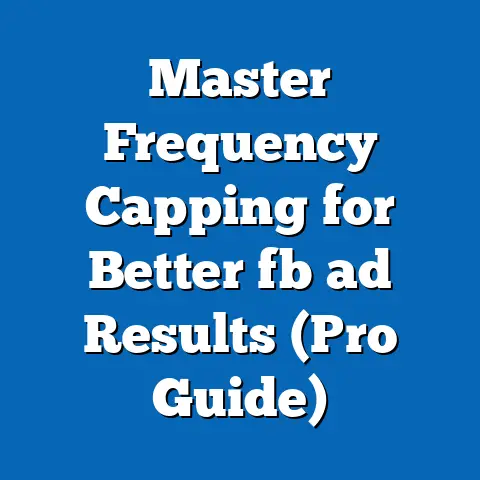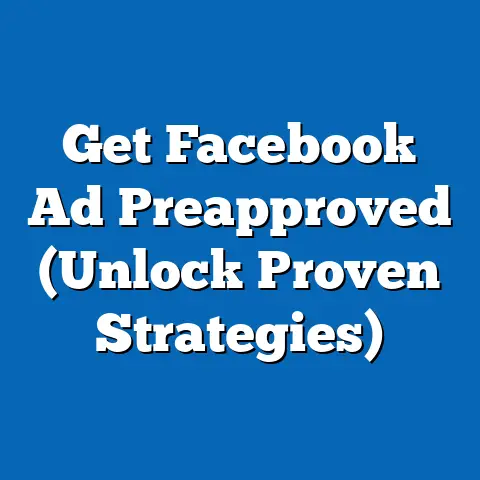Do You Pay VAT on Facebook Ads? (Essential Insights Revealed)
Imagine Sarah, a budding entrepreneur, brimming with excitement as she sets up her first Facebook ad campaign. Her small business, a charming online boutique, is her pride and joy, and she’s eager to reach a wider audience. She carefully crafts her ad copy, selects stunning product images, and targets her ideal customer. Everything seems perfect, until she encounters a question that stops her in her tracks: “Do I need to pay VAT on these ads?”
This scenario isn’t unique to Sarah. Countless business owners, especially those new to the digital marketing arena, grapple with the complexities of Value Added Tax (VAT) when it comes to Facebook advertising. With businesses allocating significant portions of their budgets to Facebook ads, understanding the VAT implications is not just important – it’s essential for maintaining healthy profit margins and avoiding potential tax compliance issues.
In this guide, I will demystify the world of VAT and its application to Facebook ads. I’ll break down the key concepts, explore international transaction complexities, and provide actionable insights to help you navigate the VAT landscape with confidence. Whether you’re a seasoned marketer or just starting out, this article will equip you with the knowledge you need to make informed decisions and optimize your Facebook advertising strategy.
Understanding VAT: A Brief Overview
Before diving into the specifics of Facebook ads, let’s establish a solid understanding of VAT. Value Added Tax (VAT) is a consumption tax levied on the value added to goods and services at each stage of production or distribution. Essentially, it’s a tax on the increment of value created at each step of the supply chain, from raw materials to the final product or service purchased by the consumer.
The significance of VAT lies in its widespread application across numerous countries worldwide, particularly in the European Union and other developed nations. Unlike sales tax, which is typically charged only at the point of sale to the end consumer, VAT is collected incrementally throughout the production and distribution process. This mechanism ensures that the tax burden is shared among all participants in the supply chain.
It’s crucial to recognize that VAT regulations vary significantly from country to country. VAT rates, registration thresholds, and compliance requirements can differ substantially, making it imperative for businesses operating internationally to understand the specific rules and obligations in each jurisdiction where they conduct business. This is especially relevant when dealing with platforms like Facebook, which facilitate global advertising campaigns.
Key Takeaway: VAT is a consumption tax applied incrementally throughout the production process. Regulations vary widely, making it essential to understand the rules in each relevant jurisdiction.
Facebook Ads and International Transactions
Facebook, as a global advertising platform, operates across borders, connecting businesses with potential customers worldwide. This international reach brings both opportunities and complexities, particularly when it comes to VAT. When you run Facebook ads, you’re essentially engaging in a transaction with Facebook, which is typically headquartered outside of your country. This international element triggers specific VAT considerations.
The key question becomes: where is the service (Facebook advertising) deemed to be supplied? The answer depends on various factors, including your business location, Facebook’s location, and the VAT rules of the relevant countries. Generally, VAT is applied based on the “place of supply” rules, which determine where the transaction is considered to have taken place for tax purposes.
Here are a few examples to illustrate how VAT might apply differently in various jurisdictions:
- European Union (EU): If your business is located in the EU and you are VAT registered, you will typically provide Facebook with your VAT identification number. In this case, Facebook will not charge you VAT under the “reverse charge” mechanism. You, as the business, are then responsible for accounting for the VAT in your own VAT return. If you are not VAT registered, Facebook will charge you the VAT rate applicable in your country.
- United Kingdom (UK): Similar to the EU, if you are a VAT-registered business in the UK, Facebook will usually not charge you VAT due to the reverse charge mechanism. You will need to account for the VAT yourself. If you are not VAT registered, Facebook will charge you VAT at the UK rate.
- United States (US): The US does not have a VAT system. Instead, it has a sales tax system, which varies by state. Facebook typically does not charge sales tax on advertising services in the US.
- Australia: If you’re running ads in Australia, you’ll likely be subject to Goods and Services Tax (GST), which is similar to VAT. The current rate is 10%. Facebook will collect this GST from advertisers who don’t provide an Australian Business Number (ABN).
Key Takeaway: Facebook’s global reach means VAT implications depend on where your business is located and the specific VAT rules of those countries. Understanding the “place of supply” rules is crucial.
When is VAT Charged on Facebook Ads?
Determining when VAT is charged on Facebook ads hinges on several factors, including your business status (business vs. personal), your VAT registration status, and the location of your business. Let’s break down these factors in detail.
Business vs. Personal Accounts:
The first distinction is whether you’re using a business account or a personal account to run your Facebook ads. If you’re advertising for personal reasons (e.g., selling personal items), you generally won’t be subject to VAT. However, if you’re advertising for business purposes, VAT considerations come into play.
VAT Registration Status:
Your VAT registration status is a critical determinant. If your business is VAT registered, meaning you’ve met the threshold for VAT registration in your country and have obtained a VAT identification number, the VAT treatment differs compared to businesses that are not VAT registered.
- VAT Registered Businesses: As mentioned earlier, in many countries, particularly within the EU and the UK, VAT-registered businesses are typically not charged VAT by Facebook directly. Instead, the “reverse charge” mechanism applies. This means you, the business, are responsible for accounting for the VAT on your VAT return. You essentially act as both the supplier and the recipient of the service for VAT purposes.
- Non-VAT Registered Businesses: If your business is not VAT registered, Facebook will typically charge you VAT at the rate applicable in your country. This is because you haven’t reached the VAT registration threshold or haven’t chosen to register voluntarily.
Threshold Limits and Registration Requirements:
It’s important to be aware of the VAT registration threshold in your country. This is the level of annual turnover (sales) that triggers the requirement to register for VAT. If your business exceeds this threshold, you must register for VAT. Even if you’re below the threshold, you may choose to register voluntarily, which can have benefits like recovering VAT on your business expenses.
Key Takeaway: VAT is typically charged on Facebook ads for business accounts. VAT-registered businesses often use the “reverse charge” mechanism, while non-VAT registered businesses are charged VAT directly by Facebook. Understanding VAT registration thresholds is essential.
How VAT is Calculated on Facebook Ads
Calculating VAT on Facebook ads involves understanding the VAT rate applicable in your country and whether the price displayed is VAT-inclusive or VAT-exclusive. Let’s walk through the calculation process with examples.
VAT-Inclusive vs. VAT-Exclusive Prices:
When you view the cost of your Facebook ads, it might be displayed as either VAT-inclusive or VAT-exclusive. VAT-inclusive means the price already includes the VAT amount, while VAT-exclusive means the VAT amount is added on top of the displayed price.
Calculating VAT Amount:
- If the price is VAT-exclusive: Simply multiply the price by the VAT rate applicable in your country. For example, if your Facebook ad cost is $100 and the VAT rate is 20%, the VAT amount is $100 x 0.20 = $20. The total cost, including VAT, would be $120.
- If the price is VAT-inclusive: You need to “back out” the VAT amount from the total price. The formula is: VAT amount = Total price x (VAT rate / (1 + VAT rate)). For example, if the total price, including VAT, is $120 and the VAT rate is 20%, the VAT amount is $120 x (0.20 / (1 + 0.20)) = $20. The VAT-exclusive price would be $100.
Examples:
Let’s say you’re running Facebook ads in Germany, where the standard VAT rate is 19%.
- Example 1 (VAT-Exclusive): Your ad campaign costs €500 (VAT-exclusive). The VAT amount is €500 x 0.19 = €95. The total cost, including VAT, is €595.
- Example 2 (VAT-Inclusive): Your ad campaign costs €595 (VAT-inclusive). The VAT amount is €595 x (0.19 / (1 + 0.19)) = €95. The VAT-exclusive cost is €500.
Finding VAT Information on Facebook Ads Manager:
Facebook Ads Manager typically displays the price of your ads VAT-exclusive. However, you can usually find details about the VAT charged on your invoices or billing statements. These documents will clearly show the VAT amount and the VAT rate applied.
Key Takeaway: Calculating VAT involves understanding whether the price is VAT-inclusive or VAT-exclusive and applying the correct VAT rate. Facebook Ads Manager provides VAT information on invoices and billing statements.
Implications for Business Owners
Understanding VAT implications is crucial for business owners using Facebook ads, especially for small and medium enterprises (SMEs) where every penny counts. Failing to account for VAT correctly can lead to financial surprises and potential tax compliance issues.
Financial Impact:
VAT can significantly impact your advertising budget. If you’re not VAT registered, you’ll be paying VAT on top of your ad spend, effectively reducing the amount you can invest in reaching your target audience. Even if you’re VAT registered and using the reverse charge mechanism, you need to ensure you’re properly accounting for the VAT on your returns, which requires accurate record-keeping and potentially the assistance of an accountant.
Accurate Accounting and Record-Keeping:
Maintaining accurate records of your Facebook ad spend and the VAT charged is essential for VAT compliance. Keep copies of your invoices, billing statements, and VAT returns. Use accounting software that can handle VAT calculations and reporting. If you’re unsure about any aspect of VAT, seek advice from a qualified accountant or tax advisor.
Common Misconceptions:
One common misconception is that VAT doesn’t matter if you’re a small business. However, even if you’re below the VAT registration threshold, understanding VAT can help you plan your finances and make informed decisions about when to register voluntarily. Another misconception is that the reverse charge mechanism means you don’t have to worry about VAT. While you might not be paying VAT directly to Facebook, you still need to account for it on your VAT return.
Key Takeaway: VAT can significantly impact your advertising budget. Accurate accounting and record-keeping are essential for VAT compliance. Be aware of common misconceptions and seek professional advice when needed.
Conclusion: The Bigger Picture
Navigating the world of VAT and Facebook ads can seem daunting, but with a clear understanding of the key concepts, you can confidently manage your advertising expenses and ensure tax compliance. We’ve covered the basics of VAT, explored the complexities of international transactions, outlined when VAT is charged on Facebook ads, and provided practical guidance on calculating VAT amounts.
The key takeaway is that VAT is a significant consideration for businesses using Facebook ads, regardless of their size or location. Staying informed about VAT regulations, maintaining accurate records, and seeking professional advice when needed are essential for optimizing your advertising strategy and avoiding potential financial pitfalls.
As the landscape of online advertising continues to evolve, understanding the financial obligations associated with digital marketing expenditures becomes increasingly crucial. By embracing a proactive approach to VAT and other tax-related matters, you can position your business for long-term success in the dynamic world of online advertising. So, Sarah, and all the other budding entrepreneurs out there, go forth and conquer the Facebook advertising world, armed with the knowledge to navigate the VAT landscape with confidence!






